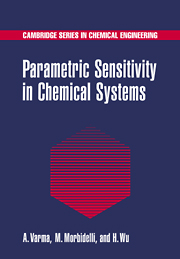Book contents
- Frontmatter
- Contents
- Preface
- 1 Introduction
- 2 Introduction to Sensitivity Analysis
- 3 Thermal Explosion in Batch Reactors
- 4 Runaway in Tubular Reactors
- 5 Parametric Sensitivity in Continuous-Flow Stirred Tank Reactors
- 6 Runaway in Fixed-Bed Catalytic Reactors
- 7 Parametric Sensitivity and Ignition Phenomena in Combustion Systems
- 8 Sensitivity Analysis in Mechanistic Study and Model Reduction
- 9 Sensitivity Analysis in Air Pollution
- 10 Sensitivity Analysis in Metabolic Processes
- Author Index
- Subject Index
4 - Runaway in Tubular Reactors
Published online by Cambridge University Press: 04 May 2010
- Frontmatter
- Contents
- Preface
- 1 Introduction
- 2 Introduction to Sensitivity Analysis
- 3 Thermal Explosion in Batch Reactors
- 4 Runaway in Tubular Reactors
- 5 Parametric Sensitivity in Continuous-Flow Stirred Tank Reactors
- 6 Runaway in Fixed-Bed Catalytic Reactors
- 7 Parametric Sensitivity and Ignition Phenomena in Combustion Systems
- 8 Sensitivity Analysis in Mechanistic Study and Model Reduction
- 9 Sensitivity Analysis in Air Pollution
- 10 Sensitivity Analysis in Metabolic Processes
- Author Index
- Subject Index
Summary
By a tubular reactor, we mean an empty tube in which a homogeneous reacting mixture flows. Typically, the reacting system may be noncatalytic, or catalytic where the catalyst is homogeneously solubilized. In some instances, fixed-bed reactors, where heterogeneous solid catalysts are used, may also behave as empty tubes. This is the case where the characteristic times of all mass and heat transports are very fast as compared to the chemical reactions, and the fixed bed is referred to as a pseudo-homogeneous tubular reactor.
A tubular reactor operating at steady-state conditions is a spatial system, and the system variables are functions of position within the reactor. There is a strong similarity between tubular and well-stirred batch reactors, temporal systems discussed in Chapter 3. In the latter case, we have seen that for exothermic reactions a temperature maximum may occur as the reaction proceeds in time, while in the former at steady-state conditions a temperature maximum may be exhibited at some location along the reactor, which is generally referred to as a hot spot. The magnitude of this hot spot should be bounded within specific limits because it may seriously affect reactor safety and performance.
The magnitude of the hot spot depends on the system parameters such as operating conditions, physicochemical properties, and reaction kinetics. For specific values of the system parameters, the hot spot may undergo large variations in response to relatively small changes in one or more of the operating conditions or parameters. In this case, the reactor is said to operate in the runaway or parametrically sensitive region. In practical applications, it is clearly desirable to avoid this operating region in the earlier stages of reactor design.
- Type
- Chapter
- Information
- Parametric Sensitivity in Chemical Systems , pp. 80 - 142Publisher: Cambridge University PressPrint publication year: 1999



